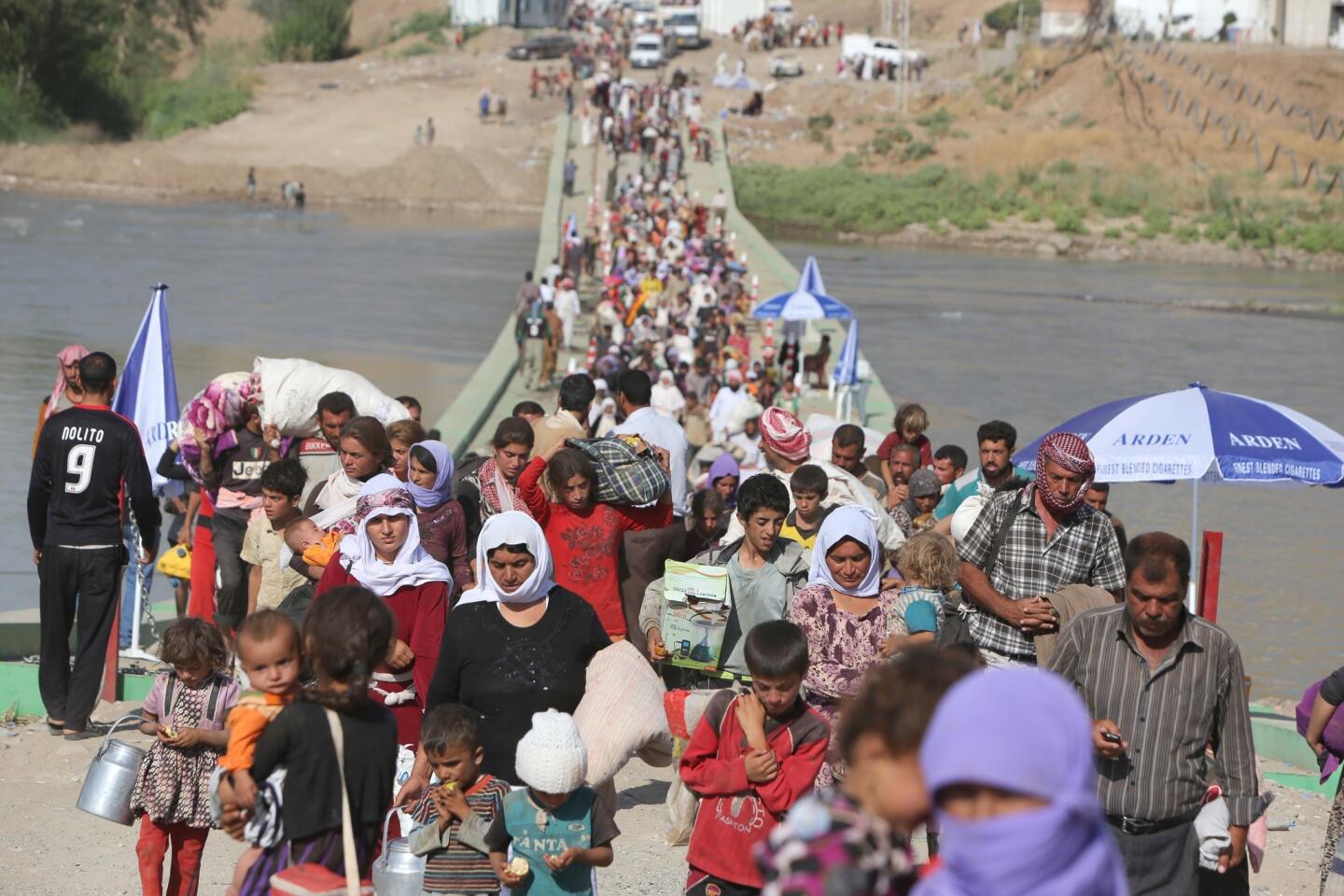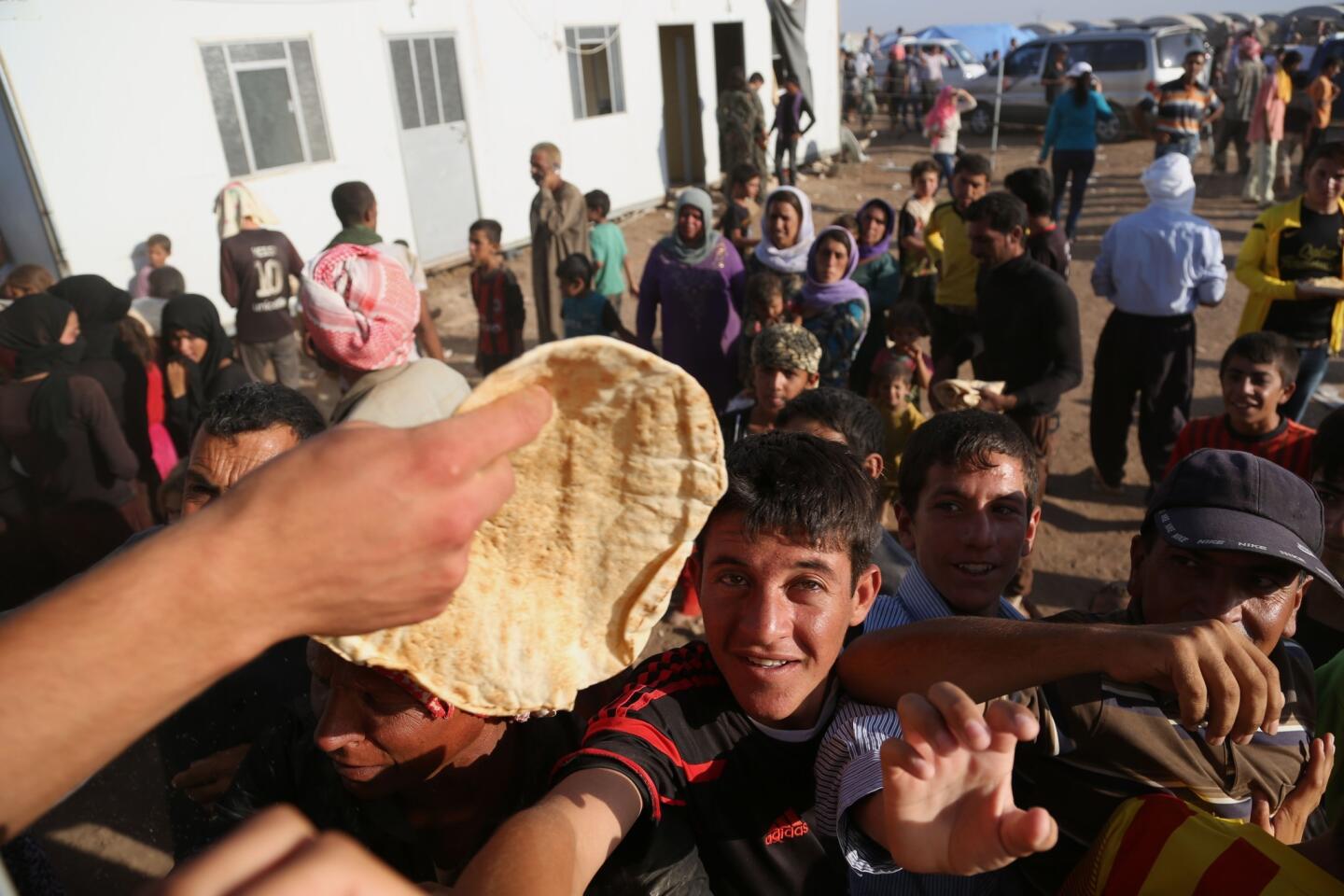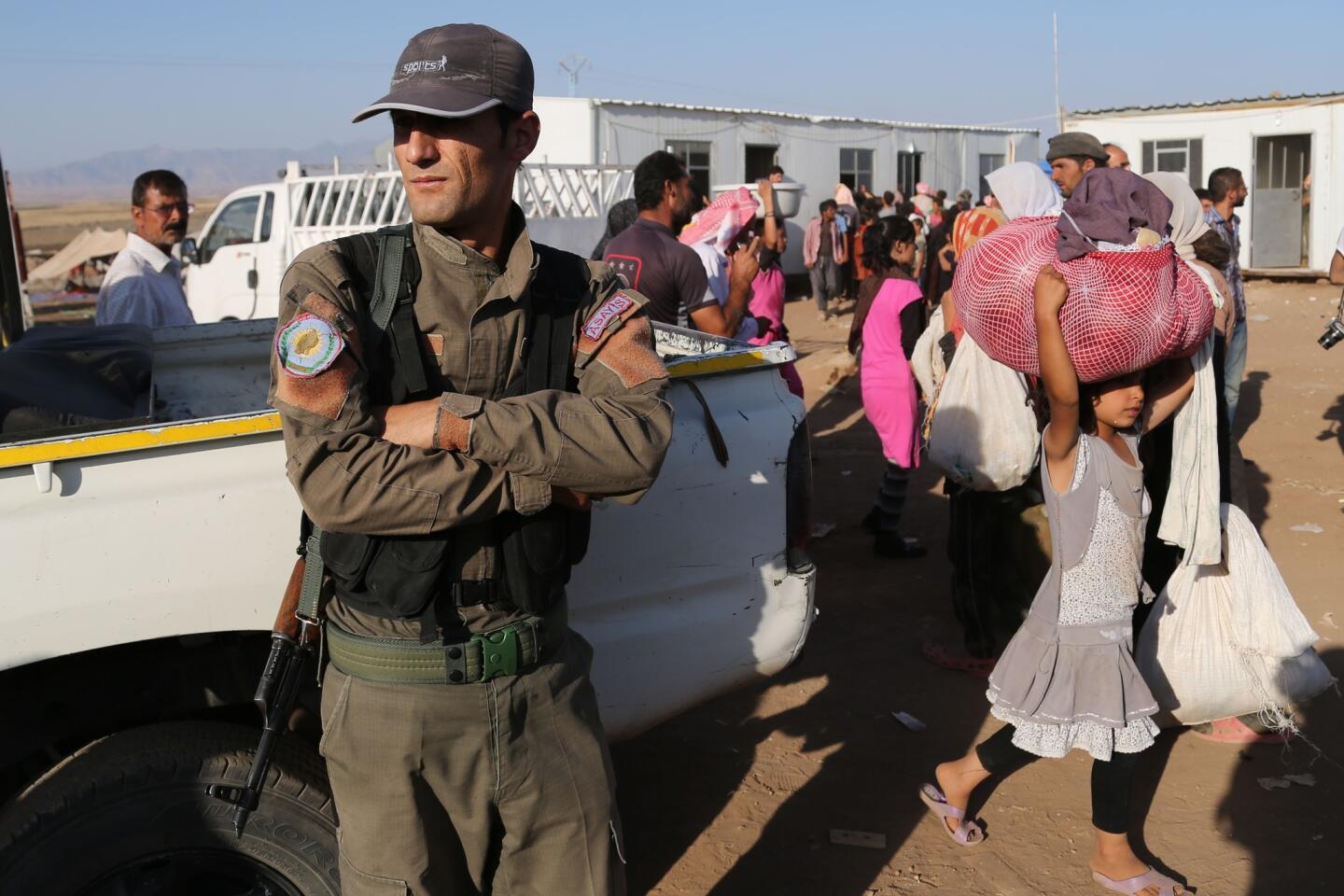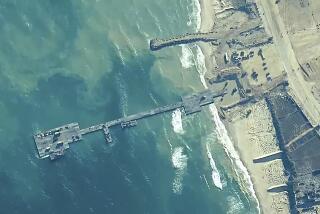U.S.: Iraqi refugees’ condition much improved; 114,000 meals dropped
- Share via
Reporting from Washington — The Pentagon said Wednesday that airdrops of food and water, airstrikes on Islamic militants and other efforts had helped dramatically improve the plight of thousands of people sheltering on a bleak mountaintop in northern Iraq, making an urgent rescue effort unlikely.
After the Pentagon landed its first team of special forces and aid workers atop Mt. Sinjar, they returned with a report saying that conditions were less desperate than White House officials had indicated earlier in the day.
Rear Adm. John Kirby, the Pentagon spokesman, said the team found far fewer Yazidi refugees than expected because thousands had managed to escape over the last several nights.
Those who remain, he said, “are in better condition than previously believed” and have access to food, water and other supplies dropped by U.S., British and Iraqi planes.
“Based on this assessment, the interagency has determined that an evacuation mission is far less likely,” he said.
Kirby also cited the effect of U.S. airstrikes on militants with the group Islamic State.
Wednesday night, U.S. planes conducted their seventh air drop of food and water to the refugees there. Two C-17 and two C-130 cargo planes dropped 108 bundles of supplies, including 7,608 gallons of drinking water and 14,112 meal rations, the Pentagon announced.
To date, the airdrops have delivered more than 114,000 meals and 35,000 gallons of water, the Pentagon statement said.
President Obama had been expected to decide within days on Pentagon recommendations for moving thousands of members of the Yazidi religious sect from Mt. Sinjar, either by organizing a military airlift or by creating a protected corridor to help them to safety, Ben Rhodes, the deputy national security advisor, said earlier Wednesday.
Any rescue operation would probably require temporarily inserting U.S. troops, who would be authorized to defend themselves if attacked by Islamic State, the heavily armed Al Qaeda breakaway faction that has been targeted by U.S. airstrikes since Friday.
In the latest U.S. attack, a missile launched from a Predator drone struck and destroyed an armed vehicle used by the militants west of the town of Sinjar on Wednesday, the Pentagon said.
With armed insurgents still on the southern approaches to the refugees’ redoubt, a military-led rescue mission would be complex and potentially risky. But Rhodes said sending U.S. troops into the war zone would not breach Obama’s pledge to keep from resuming a combat role in Iraq.
“The United States is helping to facilitate the removal of these people from the mountain on a humanitarian mission, which we believe is separate from saying U.S. forces are going to be deployed in Iraq in a combat role,” Rhodes said in Edgartown, Mass., near where the president is on a family vacation.
Fewer than 20 U.S. special forces troops and relief experts from the U.S. Agency for International Development flew for the first time to Mt. Sinjar, a broad, 30-mile ridge, from Irbil, capital of the semiautonomous Kurdish region, to help assess conditions. Their report appeared to upend any plans for an emergency evacuation, at least for now.
The Pentagon also has sent at least four Ospreys, tilt-rotor cargo aircraft, plus a number of helicopters to a “secure airfield” near Irbil as Obama weighs his options.
The White House has been drawn steadily deeper into Iraq since Obama decided last week to use airstrikes to help Kurdish troops turn back the militants’ fast-moving offensive, which directly threatened Irbil as well as the Yazidis, who fled to the mountain because the radical Sunni group had threatened to kill them as religious apostates.
Since then, helped by the U.S. airstrikes and direct deliveries of U.S weapons and ammunition, the Kurdish fighters, known as peshmerga, have retaken several strategic towns outside Irbil, and appear to have blunted the insurgent push. More than 1,000 U.S. military advisors and others are in Baghdad and Irbil.
U.S. and British aircraft separately have dropped more than 100,000 meals, 27,000 gallons of water and emergency supplies to the Yazidis. Estimates vary as to how many are stranded, ranging from several thousand to tens of thousands. Some have managed to make their way to safety via a difficult, circuitous route.
Kurdish fighters in both Iraq and Syria helped open the escape path, guiding people down the mountain slopes and to the Syrian border, where the Yazidis crossed into territory controlled by Syrian Kurdish rebels. The rebels then provided lifts in pickups and other vehicles to a spot along the Tigris River where the Yazidis were able to cross a pontoon bridge into Iraq, but this time into the Kurdish region, largely a safe zone.
“We got away with only the clothes on our backs,” said Seve Shamo, 51, one of scores of displaced Yazidis sheltering in the concrete skeleton of a school under construction in a Yazidi village outside the northern Kurdish city of Dahuk. “We left everything behind,” she added, as relatives and other escapees nodded in agreement. “We have nothing left.”
France, Australia and Canada have offered to assist the Yazidis, as well as several hundred thousand Iraqi Christians and others who have been driven from their homes by the fighting. The French government also said it would send weapons “in the next few hours” to Iraq “to support the operational capacity of the forces engaged in the battle against the Islamic State.”
So far, U.S. warplanes and armed drones have launched seven airstrikes against Islamic State positions and vehicles around Mt. Sinjar and 17 against militants advancing on Irbil, State Department spokeswoman Marie Harf said Wednesday.
“Islamic State militants are a terrorist group acting like an army,” Harf said. “Right now, we’re focused on pushing them back from this territory, helping the Kurds, the Iraqis regain this territory, and then, longer-term, helping the Iraqis develop the capabilities to degrade the terrorist group.”
At the Pentagon, spokesman Col. Steve Warren said the V-22 Ospreys, which can land and take off like helicopters, were positioned near Irbil with about 130 Marines and special operations soldiers that the Pentagon sent to help assess the conditions on Mt. Sinjar and help stage any rescue operation.
The Ospreys’ ability to land under harsh conditions without paved runways would make them especially useful in an airlift. But each aircraft can carry only two dozen or so passengers, so transporting thousands of people would be a massive logistical undertaking, officials said.
In addition, although the militants do not have antiaircraft weapons that could threaten U.S. fighters, they have small weapons that could bring down low-flying helicopters and even the propeller-driven Osprey.
As a result, any rescue would involve both air and ground operations, with aircraft taking off the most vulnerable, and vehicles used to help lead the other refugees to safety under military protection, said an official, who asked that his name not be used.
The easiest route would be to the south, but the militants hold much of the area. The safer route, both for U.S. troops and the refugees, would probably be to the northwest toward the Syrian border, he said.
A protected corridor could be established so the refugees could cross into Syria, as some already have, and then move north along the border into Iraqi Kurdistan, officials said. How many troops it would take to defend such an area is unclear, but it would probably involve U.S. fighters overhead to guard against militant attacks on columns of refugees.
Cloud reported from Washington and Hennessey from Edgartown, Mass.
For more news about the U.S. and Iraq, follow @khennessey and @DavidCloudLAT on Twitter.
More to Read
Sign up for Essential California
The most important California stories and recommendations in your inbox every morning.
You may occasionally receive promotional content from the Los Angeles Times.


















